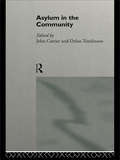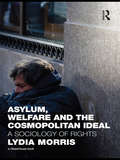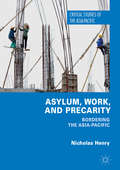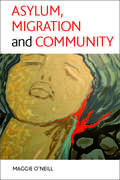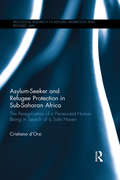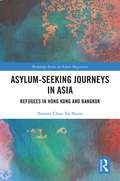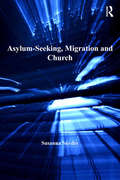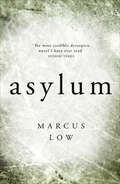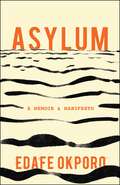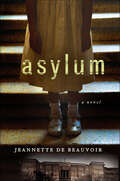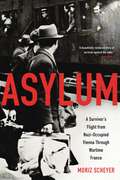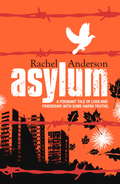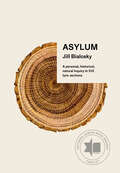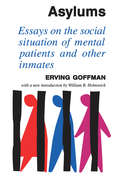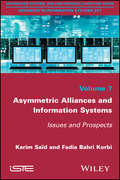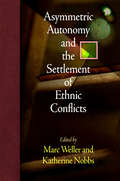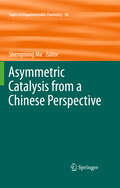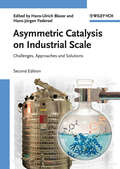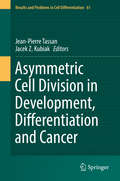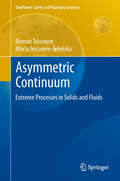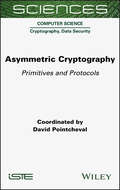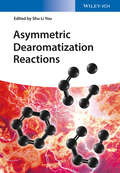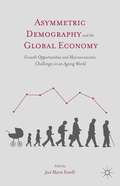- Table View
- List View
Asylum in the Community
by John Carrier Dylan TomlinsonBased on an empirical examination of psychiatric care both past and present,Asylum in the Community clearly defines the concept of asylum and shows how it can be provided effectively outside the hospital. Drawing on work in the USA, Belgium, Spain, Ireland and England, contributors analyse such services from both user and provider perspectives. From these analyses the editors establish the key elements that should be considered in developing contemporary community services for the mentally ill. Asylum in the Community provides a balanced assessment of a controversial, topical issue for managers and providers of mental health services and those teaching or training in the mental health sciences.
Asylum, Welfare and the Cosmopolitan Ideal: A Sociology of Rights
by Lydia MorrisAsylum, Welfare and the Cosmopolitan Ideal: A Sociology of Rights puts forward the argument that rights must be understood as part of a social process: a terrain for strategies of inclusion and exclusion but also of contestation and negotiation. Engaging debate about how ‘cosmopolitan’ principles and practices may be transforming national sovereignty, Lydia Morris explores this premise through a case study of legal activism, civil society mobilisation, and judicial decision-making. The book documents government attempts to use destitution as a deterrent to control asylum numbers, and examines a series of legal challenges to this policy, spanning a period both before and after the Human Rights Act. Lydia Morris shows how human rights can be used as a tool for radical change, and in so doing proposes a multi-layered 'model' for understanding rights. This incorporates political strategy, public policy, civil society mobilisation, judicial decision-making, and their public impact, and advances a dynamic understanding of rights as part of the recurrent encounter between principles and politics. Rights are therefore seen as both a social product and a social force.
Asylum, Work, and Precarity: Bordering the Asia-Pacific (Critical Studies of the Asia-Pacific)
by Nicholas HenryThis book explores the regional coordination and impact of state responses to irregular migration in Southeast Asia and the Pacific. The main argument is that regional and international trends of securitisation and criminalisation of irregular migration, often associated with framing the issue in terms of migrant smuggling and human trafficking, have intensified carceral border regimes and produced greater precarity for migrants. Bilateral and multilateral processes of regional coordination at multiple levels of government are analysed with a focus on the impact on asylum seekers and migrant workers in major destination and transit countries including Malaysia, Thailand, Singapore, Indonesia, and Australia. The book will be of interest to a wide academic audience interested in the interdisciplinary field of Border Studies, as well as general readers concerned with the treatment of refugees and migrant workers who cross borders in search of safety, security, and a better life.
Asylum, migration and community
by Maggie O'NeillIssues of asylum, migration, humanitarian protection and integration/belonging are of growing interest beyond the disciplines of refugee studies, migration, and social policy. Rooted in more than two decades of scholarship, this book uses critical social theory and the participatory, biographical and arts-based methods used with asylum seekers, refugees and emerging communities to explore the dynamics of the asylum-migration-community nexus. It argues that interdisciplinary analysis is required to deal with the complexity of the issues involved and offers understanding as praxis (purposeful knowledge), drawing on innovative research that is participatory, arts-based, performative and policy-relevant.
Asylum-Seeker and Refugee Protection in Sub-Saharan Africa: The Peregrination of a Persecuted Human Being in Search of a Safe Haven (Routledge Research in Asylum, Migration and Refugee Law)
by Cristiano d'OrsiIt is not often acknowledged that the great majority of African refugee movement happens within Africa rather than from Africa to the West. This book examines the specific characteristics and challenges of the refugee situation in Sub-Saharan Africa, offering a new and critical vision on the situation of asylum-seekers and refugees in the African continent. Cristiano d’Orsi considers the international, regional and domestic legal and institutional frameworks linked to refugee protection in Sub-Saharan Africa, and explores the contributions African refugee protection has brought to the cause on a global scale. Key issues covered in the book include the theory and the practice of non-refoulement, an analysis of the phenomenon of mass-influx, the concept of burden-sharing, and the role of freedom fighters. The book goes on to examine the expulsions of refugees and the historical role played by UNHCR in Sub-Saharan Africa. As a work which follows the persecution and legal challenges of those in search of a safe haven, this book will be of great interest and use to researchers and students of immigration and asylum law, international law, human rights, and African studies.
Asylum-Seeking Journeys in Asia: Refugees in Hong Kong and Bangkok (Routledge Series on Asian Migration)
by Terence Chun ShumThis book looks in detail at the journeys to asylum in Asia which are largely neglected in the media and academic analyses, despite Asia becoming the most essential region for asylum, receiving refugees from both within and outside of the continent. Treating asylum-seeking journeys as a transnational space, the author investigates the actual asylum-seeking process from homelands to either Hong Kong or Bangkok. Today, refugees undertake multiple, long, and life-threatening journeys before arriving in receiving societies; from the moment of arrival in Hong Kong or Bangkok, they face a wide array of challenges. An ethnographic account of how refugees navigate and negotiate their journeys to asylum, this book highlights the social, political, economic, and psychological processes involved in "becoming" and "being" a refugee. This encompasses not only the physical movement of refugees, but also their embodiments and emotional encounters. The author offers a micro-level analysis of asylum-seeking journeys - from the aspiration to flee, to migration preparation, to border crossing, to homemaking in prolonged displacement. All of these stages reveal how these journeys create ever-evolving realities with new constellations of options and constraints. By focusing on refugees’ understanding, perception of, and interaction with the people, environments, and situations around them, this book illustrates how refugee life plans are shaped and reshaped by the embodied experience of their journeys, and how their ideas of home have changed over time. Asylum-seeking Journeys in Asia will appeal to scholars and students in the fields of migration and refugee studies, diaspora studies, globalisation, and Asian studies. It will also be of interest to policymakers and humanitarian workers involved in providing services and assistance to the global refugee population.
Asylum-Seeking, Migration and Church: Aliens And Angels (Explorations in Practical, Pastoral and Empirical Theology)
by Susanna SnyderAsylum-Seeking, Migration and Church addresses one of the most pressing issues confronting contemporary society. How are we to engage with migrants? Drawing on studies of church engagement with asylum seekers in the UK and critical immigration and refugee issues in North America, Snyder presents an extended theological reflection on both the issue of asylum-seeking and the fears of established populations surrounding immigration. This book outlines ways in which churches are currently supporting asylum seekers, encouraging closer engagement with people seen as 'other' and more thoughtful responses to newcomers. Creatively exploring biblical and theological traditions surrounding the 'stranger', Snyder argues that as well as practising a vision of inclusive community churches would do well to engage with established population fears. Trends in global migration and the dynamics of fear and hostility surrounding immigration are critically and creatively explored throughout the book. Inviting more complex, nuanced responses to asylum seekers and immigrants, this book offers invaluable insights to those interested in Christian ethics, practical theology, social work, mission and faith and social action, as well as those working in the field of migration.
Asylum: 'the Most Credible Dystopian Novel I Have Ever Read' Sunday Times
by Marcus LowBarry James is detained in a quarantine facility in the blistering heat of the Great Karoo. Here he exists in two worlds: the unforgiving reality of his incarceration and the lyrical landscapes of his dreams.He has cut all ties with his previous life, his health is failing, and he has given up all hope. All he has to cling to are the meanderings of his restless mind, the daily round of pills and the journals he reluctantly keeps as testimony to a life once lived.And then there’s an opportunity to escape.LONGLISTED FOR THE GUARDIAN'S NOT THE BOOKER PRIZE 2019'The most credible dystopian novel I have ever read' Sunday Times'A searing vision of an all-too-possible world... a profound and wholly original voice' Henrietta Rose-Innes'A forceful and engaging tale that brilliantly blends the real and imagined world and is full of sparkling inventions. This page-turner is bound to be the talk of book circles' Niq Mhlongo'Thought-provoking, alluring and sensitively written... a new thrilling talent' Cape TimesShortlisted for the 9Mobile Prize for Literature
Asylum: A Memoir & Manifesto
by Edafe OkporoA poignant, moving memoir and urgent call to action for immigration justice by a Nigerian asylee and global gay rights and immigration activist Edafe Okporo.On the eve of Edafe Okporo&’s twenty-sixth birthday, he was awoken to a violent mob outside his window in Abuja, Nigeria. The mob threatened his life after discovering the secret Edafe had been hiding for years—that he is a gay man. Left with no other choice, he purchased a one-way plane ticket to New York City and fled for his life. Though America had always been painted to him as a land of freedom and opportunity, it was anything but when he arrived just days before the tumultuous 2016 Presidential Election. Edafe would go on to spend the next six months at an immigration detention center in Elizabeth, New Jersey. After navigating the confusing, often draconian, US immigration and legal system, he was finally granted asylum. But he would soon realize that America is exceptionally good at keeping people locked up but is seriously lacking in integrating freed refugees into society. Asylum is Edafe&’s eye-opening, thought-provoking memoir and manifesto, which documents his experiences growing up gay in Nigeria, fleeing to America, navigating the immigration system, and making a life for himself as a Black, gay immigrant. Alongside his personal story is a blaring call to action—not only for immigration reform but for a just immigration system for refugees everywhere. This book imagines a future where immigrants and asylees are treated with fairness, transparency, and compassion. It aims to help us understand that home is not just where you feel safe and welcome but also how you can make it feel safe and welcome for others.
Asylum: A Novel (Martine LeDuc #1)
by Jeannette de BeauvoirMartine LeDuc is the director of PR for the mayor's office in Montreal. When four women are found brutally murdered and shockingly posed on park benches throughout the city over several months, Martine's boss fears a PR disaster for the still busy tourist season, and Martine is now also tasked with acting as liaison between the mayor and the police department. The women were of varying ages, backgrounds and bodytypes and seemed to have nothing in common. Yet the macabre presentation of their bodies hints at a connection. Martine is paired with a young detective, Julian Fletcher, and together they dig deep into the city's and the country's past, only to uncover a dark secret dating back to the 1950s, when orphanages in Montreal and elsewhere were converted to asylums in order to gain more funding. The children were subjected to horrific experiments such as lobotomies, electroshock therapy, and psychotropic medication, and many of them died in the process. The survivors were supposedly compensated for their trauma by the government and the cases seem to have been settled. So who is bearing a grudge now, and why did these four women have to die?Not until Martine finds herself imprisoned in the terrifying steam tunnels underneath the old asylum does she put the pieces together. And it is almost too late for her...in Jeannette de Beauvoir's Asylum.
Asylum: A Survivor's Flight from Nazi-Occupied Vienna Through Wartime France
by P. N. Singer Moriz ScheyerA recently discovered account of an Austrian Jewish writer's flight, persecution, and clandestine life in wartime France.As arts editor for one of Vienna's principal newspapers, Moriz Scheyer knew many of the city's foremost artists, and was an important literary journalist. With the advent of the Nazis he was forced from both job and home. In 1943, in hiding in France, Scheyer began drafting what was to become this book. Tracing events from the Anschluss in Vienna, through life in Paris and unoccupied France, including a period in a French concentration camp, contact with the Resistance, and clandestine life in a convent caring for mentally disabled women, he gives an extraordinarily vivid account of the events and experience of persecution. After Scheyer's death in 1949, his stepson, disliking the book's anti-German rhetoric, destroyed the manuscript. Or thought he did. Recently, a carbon copy was found in the family's attic by P.N. Singer, Scheyer's step-grandson, who has translated and provided an epilogue.
Asylum: A Survivor's Flight from Nazi-Occupied Vienna Through Wartime France
by Rachel AndersonSet in an about-to-be-demolished high-rise block of flats, various characters have arrived from a variety of situations; their lives and their stories, interweave, change and affect each other, and travel towards deeply moving, often funny, happy and painful outcomes. At the core of the story are two asylum seekers: All fifteen-year-old Sunday wanted was a country that was democratic and respectful of human life. All eight-year-old Rosa wanted was somewhere safe, away from the bad things of the past. Through their eyes, ideas of Britain> and belonging are explored. Moving, thoughtful, outstanding and unforgettable.
Asylum: A personal, historical, natural inquiry in 103 lyric sections
by Jill BialoskyThis book-length sequence by the critically acclaimed poet is a seeker's story, revealing personal and historical traumas and how we search for understanding and meaning in their wake.In Asylum, poet Jill Bialosky embarks on a Virgilian journey, building a narrative sequence from 103 elegant poems and prose sections that cohere in their intensity and their need to explore darkness and sustenance both. Taken together, these piercing pieces--about her nascent calling as a writer; her sister's suicide and its still unfolding aftermath; the horror unleashed by World War II; the life cycle of the monarch butterfly; and the woods where she seeks asylum--form a moving story, powerfully braiding despair, survival, and hope. Bialosky considers the oppositions that govern us: our reason and unreason, our need to preserve and destruct. "What are words when they meet the action of what they attempt to modify?" she asks, exploring the possible salve of language in the face of pain and grief. What Asylum delivers is a form of hard-won grace and an awareness of the cost of extreme violence, inexplicable loss, and the miraculous cycles of life, in work that carries Bialosky's art to a new level of urgency and achievement.
Asylums: Essays on the Social Situation of Mental Patients and Other Inmates (Pelican Ser.)
by Erving GoffmanA total institution is defined by Goffman as a place of residence and work where a large number of like-situated, individuals, cut off from the wider society for an appreciable period of time, together lead an enclosed, formally administered round of life. Prisons serve as a clear example, providing we appreciate that what is prison-like about prisons is found in institutions whose members have broken no laws. This volume deals with total institutions in general and, mental hospitals, in particular. The main focus is, on the world of the inmate, not the world of the staff. A chief concern is to develop a sociological version of the structure of the self.Each of the essays in this book were intended to focus on the same issue--the inmate's situation in an institutional context. Each chapter approaches the central issue from a different vantage point, each introduction drawing upon a different source in sociology and having little direct relation to the other chapters.This method of presenting material may be irksome, but it allows the reader to pursue the main theme of each paper analytically and comparatively past the point that would be allowable in chapters of an integrated book. If sociological concepts are to be treated with affection, each must be traced back to where it best applies, followed from there wherever it seems to lead, and pressed to disclose the rest of its family.
Asymmetric Adjustment and Nonlinear Dynamics in Real Exchange Rates
by Hyginus Leon Serineh NajarianA report from the International Monetary Fund.
Asymmetric Alliances Management via Information Systems: Issues and Prospects
by Fadia Bahri Korbi Karim SaidThis book explores the impact of information systems on the management of North–South asymmetric strategic alliances through a series of in-depth case studies which analyze different types of partnerships. Positioned at the heart of the value creation process, the choice of information system seems to be becoming a strategic issue which should be centered not only on the organizational decisions related to the type of alliance but also the management systems of each of the partners. The authors provide an understanding of the nature of this relationship between the organizational structure and the method of information system integration in asymmetric alliances. The in-depth analysis of strategic alliance case-studies illustrates the different methods of information system integration, which are themselves linked to the organisational and structural choices of the alliance. These methods are characterized by information-sharing and coordination mechanisms as well as the balance of control over shared activities developed by the distinct partners.
Asymmetric Autonomy and the Settlement of Ethnic Conflicts (National and Ethnic Conflict in the 21st Century)
by Marc Weller Katherine NobbsThroughout the world many sovereign states grant one or more of their territories greater autonomy than other areas. This arrangement, known as asymmetric autonomy, has been adopted with greater regularity as a solution to ethnic strife and secessionist struggles in recent decades. As asymmetric autonomy becomes one of the most frequently used conflict resolution methods, examination of the positive and negative consequences of its implementation, as well as its efficacy, is vital.Asymmetric Autonomy and the Settlement of Ethnic Conflicts assesses the ability of such power distribution arrangements to resolve violent struggles between central governments and separatist groups. This collection of new case studies from around the world covers a host of important developments, from recentralization in Russia, to "one country, two systems" in China, to constitutional innovation in Iraq. As a whole, these essays examine how well asymmetric autonomy agreements can bring protracted and bloody conflicts to an end, satisfy the demands of both sides, guarantee the physical integrity of a state, and ensure peace and stability. Contributors to this book also analyze the many problems and dilemmas that can arise when autonomous regions are formed. For example, powers may be loosely defined or unrealistically assigned to the state within a state. Redrawn boundaries can create new minorities and make other groups vulnerable to human rights violations. Given the number of limited self-determination systems in place, the essays in this volume present varied evaluations of these political structures.Asymmetric state agreements have the potential to remedy some of humanity's most intractable disputes. In Asymmetric Autonomy and the Settlement of Ethnic Conflicts, leading political scientists and diplomatic experts shed new light on the practical consequences of these settlements and offer sophisticated frameworks for understanding this path toward lasting peace.
Asymmetric Catalysis from a Chinese Perspective (Topics in Organometallic Chemistry #36)
by Shengming MaQi-Lin Zhou and Jian-Hua Xie: Chiral Spiro Catalysts.- Fuk Loi Lam, Fuk Yee Kwong and Albert S. C. Chan: Chiral Phosphorus Ligands with Interesting Properties and Practical Applications.- Jiang Pan, Hui-Lei Yu, Jian-He Xu, Guo-Qiang Lin: Advances in Biocatalysis: Enzymatic Reactions and Their Applications.- Mei-Xiang Wang: Enantioselective Biotransformations of Nitriles.- Man Kin Wong, Yiu Chung Yip and Dan Yang: Asymmetric Epoxidation Catalyzed by Chiral Ketones.- W. J. Liu, N. Li and L. Z. Gong: Asymmetric Organocatalysis.- Qing-Hua Fan and Kuiling Ding: Enantioselective Catalysis with Structurally Tunable Immobilized Catalysts.- Chang-Hua Ding, Xue-Long Hou: Transition Metal-Catalyzed Asymmetric Allylation.- Jian Zhou and Yong Tang: Enantioselective Reactions with Trisoxazolines.- Xiang-Ping Hu, Duo-Sheng Wang, Chang-Bin Yu, Yong-Gui Zhou, and Zhuo Zheng: Adventure in Asymmetric Hydrogenation: Synthesis of Chiral Phosphorus Ligands and Asymmetric Hydrogenation of Heteroaromtics.
Asymmetric Catalysis on Industrial Scale: Challenges, Approaches and Solutions
by Hans-Ulrich Blaser et al.This second edition of the pioneering work on this hot topic captures the major trends and latest achievements in the art of asymmetric catalysis on an industrial scale. A number of completely new real-life case studies written by the world leaders in their respective areas provide a compact and qualified insight into this developing field. The resulting ready reference and handbook collates first-hand and valuable information within a context where it can be easily found. The high-quality contributions illustrate the relevant environments and situations, such as time pressure, how the catalytic step fits into the overall synthesis, or competition with other synthetic approaches, as well as the typical problems encountered in the various phases, including finding/developing the catalyst and optimization of the process or choice of equipment. Both successful and unsuccessful approaches to solve these problems are described.
Asymmetric Cell Division in Development, Differentiation and Cancer (Results and Problems in Cell Differentiation #61)
by Jacek Z. Kubiak Jean-Pierre TassanThis book provides readers with an overview of the frequent occurrence of asymmetric cell division. Employing a broad range of examples, it highlights how this mode of cell division constitutes the basis of multicellular organism development and how its misregulation can lead to cancer. To underline such developmental correlations, readers will for example gain insights into stem cell fate and tumor growth. In turn, subsequent chapters include descriptions of asymmetric cell division from unicellular organisms to humans in both physiological and pathological conditions. The book also illustrates the importance of this process for evolution and our need to understand the background mechanisms, offering a valuable guide not only for students in the field of developmental biology but also for experienced researchers from neighboring fields.
Asymmetric Continuum: Extreme Processes in Solids and Fluids (GeoPlanet: Earth and Planetary Sciences #3)
by Roman Teisseyre Maria Teisseyre-JeleńskaThis book deals with a class of basic deformations in Asymmetric Continuum Theory. It describes molecular deformations and transport velocities in fluids, strain deformations in solids as well as the molecular transport, important in fracture processes. In solids, a separate problem relates to the displacements; their recording, e. g. , by means of the seismometers, proves only the existence of the displacement derivatives and not a real displacement. However, the molecular displacements and new fracture criterion including the defect distributions and induced strains are defined in the book too. In fluids, the transport velocities and molecular strains describe the motion processes. The vortex motions are defined by means of the rotational transport; this approach leads to more complicated problems, like the turbulence phenomena. The interaction processes, including the electric and magnetic fields, and some thermodynamical problems and quantum theory analogies help to understand the extreme processes
Asymmetric Crisis in Europe and Possible Futures: Critical Political Economy and Post-Keynesian Perspectives (RIPE Series in Global Political Economy)
by Elisabeth Springler Johannes JägerThe crisis in Europe is often discussed as a crisis of European integration or a crisis of national economies within Europe. Both the ‘methodological Europeanism’ and ‘methodological nationalism’ miss out the important links between economic and political processes at different spatial scales within Europe, and therefore, asymmetries and phenomena of uneven development. In addition, a discussion of possible scenarios which systematically addresses the implications of anti-crisis policies is missing. This volume seeks to close this gap by systematically integrating the analysis of economic policy or ‘technical’ solutions to the crisis within a broader framework of political economy. It argues that combining critical political economy approaches and post-Keynesian perspectives allows for a systematic understanding of the economic and political dimensions of the crisis. Although both approaches have the capacity to deal with asymmetries and uneven development, the heterogeneity in Europe has been an often largely neglected dimension of analysis. However, this recent crisis has shown that this is an essential dimension which has to be addressed in order to better understand the dynamics of European development and integration. Hence, this book aims to deal with asymmetries in Europe and to bridge the gap between the two perspectives. This work will initiate an integrative debate that is crucial for a deeper understanding of the current crisis and is an important resource for all students and scholars of IPE, European political economy and European politics.
Asymmetric Cryptography: Primitives and Protocols
by David PointchevalPublic key cryptography was introduced by Diffie and Hellman in 1976, and it was soon followed by concrete instantiations of public-key encryption and signatures; these led to an entirely new field of research with formal definitions and security models. Since then, impressive tools have been developed with seemingly magical properties, including those that exploit the rich structure of pairings on elliptic curves. <p><p> Asymmetric Cryptography starts by presenting encryption and signatures, the basic primitives in public-key cryptography. It goes on to explain the notion of provable security, which formally defines what "secure" means in terms of a cryptographic scheme. A selection of famous families of protocols are then described, including zero-knowledge proofs, multi-party computation and key exchange. <p><p> After a general introduction to pairing-based cryptography, this book presents advanced cryptographic schemes for confidentiality and authentication with additional properties such as anonymous signatures and multi-recipient encryption schemes. Finally, it details the more recent topic of verifiable computation.
Asymmetric Dearomatization Reactions
by Shu-Li YouThe first comprehensive account of the rapidly growing field of asymmetric dearomatization reactions with a focus on catalytic methods. It introduces the concept of dearomatization and describes recent progress in asymmetric reaction procedures with different catalyst systems, such as organocatalysts, transition metal catalysts, and enzymes. Chapters on dearomatizations of electron-deficient aromatic rings, dearomatization reactions via transition metal-catalyzed cross-couplings as well as dearomatization strategies in the synthesis of complex natural products are also included. Written by pioneers in the field, this is a highly valuable source of information not only for professional synthetic chemists in academia and industry but also for all those are interested in asymmetric methodologies and organic synthesis in general.
Asymmetric Demography and the Global Economy: Growth Opportunities and Macroeconomic Challenges in an Ageing World
by José María Fanelli<p>The global demographic transition presents marked asymmetries as poor, emerging, and advanced countries are undergoing different stages of transition. Emerging countries are demographically younger than advanced economies. This youth is favorable to growth and generates a demographic dividend. However, the future of emerging economies will bring a decline in the working-age share and a rise in the older population, as is the case in today's developed world. Hence, developing countries must get rich before getting old, while advanced economies must try not to become poorer as they age. <p>Asymmetric Demography and the Global Economy contributes to our understanding of why this demographic transition matters to the domestic macroeconomics and global capital movements affect the asset accumulation, growth potential, current account, and the economy's international investment position. This collaborative collection approaches these questions from the perspective of "systemically important" emerging countries i.e., members of the G20 but considers both the national and the global sides of the problem.
